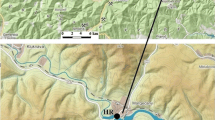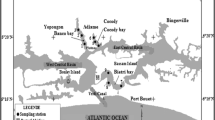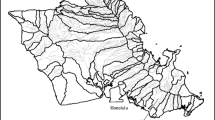Abstract
A river embankment sediment beneath a road bridge in South Australia had been surveyed on a previous occasion to a depth of 10 cm and found to contain high levels of copper, lead and zinc deposited during previous lead and zinc-based primer paint stripping operations prior to repainting the bridge. Since the river embankment is geologically different from the surrounding non-embankment soils, and a sufficient distance from the bridge along the river embankment could not be traversed, the geological background Cu, Pb and Zn fraction was established initially using a solid phase sequential extraction (SPSE) procedure. Assessment of the degree of contamination and extent of vertical mobility was then established. Copper was a minor contaminant and present predominantly as the geological background species. Lead was partitioned evenly between the oxalate soluble fraction and residual fraction to a depth of 30 cm with a decrease in total Pb concentration from 497 to 141 mg Pb kg−1 while Zn was predominantly in the oxalate soluble fraction to a depth of 15cm with a decrease in concentration from 1013 to 150 mg Zn kg−1. The reduced rate of nitrification and the lower total concentration of NO3 −-N together with the higher respiratory quotient, combined with the lower microbial quotient, are indicative of microbial stress due to heavy metal toxicity. In the case of Pb and Zn paint stripping residues, these changes in indicators of microbial health are possibly the result of the greater abundance and hence possible bioavailabilty of organo- and chloro-Pb compared to organo- and chloro-Zn complexes.
Similar content being viewed by others
References
ANZECC and NHMRC.: 1992, Australian and New Zealand Guidelines for the Assessment and Management of Contaminated Sites, Australian Government Publishing Service, Canberra.
Balzer, W. and Ahrens, E.: 1991, Mikrobiologische bewertung von böden aus dauerversuchen mit faulschlamm, in: Sauerbeck, D. and Lübben, S. (eds) Auswirkungen von Siedlungsabfällen auf Böden. Bödenorganismen und Pflanze, Berichte aus de Ökologische Forschung Band 6, Forschungszentrum, Jülich, pp. 359-389.
Brookes, P.C.: 1995, The use of microbial parameters in monitoring soil pollution by heavy metals, Biology and Fertility of Soils 19, 269-279.
Brookes, P.C. and McGrath, S.P.: 1984, Effects of metal toxicity on the size of the soil microbial biomass, Journal of Soil Science 35, 341-346.
Cartwright, B., Merry, R.H. and Tiller, K.G.: 1977, Heavy metal contamination of soils around a lead smelter at Pt. Pirie, South Australia Australian, Journal of Soil Research 15, 69-81.
Chander, K.: 1991, The Effects of Heavy Metals from Past Applications of Sewage Sludge on Soil Microbial Biomass and Microbial Activity, PhD Thesis, University of Reading.
Chander, K. and Brookes, P.C.: 1993, Residual effects of zinc, copper and nickel in sewage sludge on microbial biomass in a sandy loam, Soil Biology and Biochemistry 25, 1231-1239.
Doelman, P.: 1986, Resistance of Soil Microbial Communities to Heavy Metals, in: Jensen, J., Kjøller, A., and Sørensen, L.H. (eds) Microbial Communities in Soil. FEMS Symposium No. 33. Elsevier, Copenhagen London New York, pp. 369-384.
McBride, M.B., Richards, B.K., Steenhuis, T., Russo, J.J. and Sauvé, S.: 1995, Mobility and solubility of toxic metals and nutrients in soil fifteen years after sludge application, Soil Science 162, 487-500.
McGrath, S.P. and Cegarra, J.: 1992, Chemical extractability of heavy metals during and after longterm applications of sewage sludge to soil, Journal of Soil Science 43, 313-321.
Soil Survey Staff: 1992, Keys to Soil Taxonomy, SMSS Technical Monograph No. 19, 5th edn, Pocahontas Press, Blacksburg, Virginia.
Shuman, L.M.: 1985, Fractionation method for soil microelements, Soil Science 140, 11-22.
Sauvé, S., McBride, M.B. and Hendershot, W.H.: 1997, Speciation of lead contaminated soils, Environmental Pollution 98, 149-155.
Sauvé, S., Hendershot, W. and Allen, H.: 2000, Solid-solution partitioning of metals in contaminated soils: Dependence on pH, total metal burden, and organic matter, Environmental Science and Technology 34, 1125-1131.
Rayment, G.E. and Higginson, F.R.: 1992, Australian Laboratory Handbook of Soil and Water Chemical Methods, Inkata Press, Melbourne, Australia.
Rogers, S.L. and Tiller, K.G.: 1996, Influence of Metal Contaminated Sewage Biosolid Application to Soils on C and N Mineralisation and Microbial Biomass, in: Water Technology, Australian Water and Waste Water Association, Sydney, Australia, pp. 99-105.
USDA: 1982, United States Department of Agriculture, Soil Conservation Service. Particle-size Analyses, in: Procedures for Collecting Soil Samples and Methods of Analysis for Soil Survey, Soil Survey Investigation Report No. 1, SCS, Washington D.C.
Valsecchi, G., Gigliotti, C. and Farini, A.: 1995, Microbial biomass, activity, and organic matter accumulation in soils contaminated with heavy metals, Biology and Fertility of Soils 20, 253-259.
Vance, E.D., Brookes, P.C. and Jenkinson, D.S.: 1987, An extraction method for measuring soil biomass C, Soil Biology and Biochemistry 19, 703-707.
Wu, J., Joergensen, R.G., Pommerening, B., Chaussod, R. and Brookes, P.C.: 1990, Measurement of soil microbial biomass C by fumigation-extraction-an automated procedure, Soil Biology and Biochemistry 22, 1167-1169.
Zarcinas, B.A.: 1997, A survey of the ‘old’ Murray Bridge paddock to assess the level of copper, lead and zinc contamination from previous paint stripping operations, Project Final Report (Confidential) for Transport SA.
Zarcinas, B.A., McLaughlin, M.J. and Smart, M.K.: 1996, The effect of acid digestion technique on the performance of nebulization systems used in inductively coupled plasma spectrometry, Communications in Soil Science and Plant Analysis 27, 1331-1354.
Author information
Authors and Affiliations
Corresponding author
Rights and permissions
About this article
Cite this article
Zarcinas, B.A., Rogers, S.L. Copper, Lead and Zinc Mobility and Bioavailability in a River Sediment Contaminated with Paint Stripping Residue. Environmental Geochemistry and Health 24, 191–203 (2002). https://doi.org/10.1023/A:1016061407072
Issue Date:
DOI: https://doi.org/10.1023/A:1016061407072




